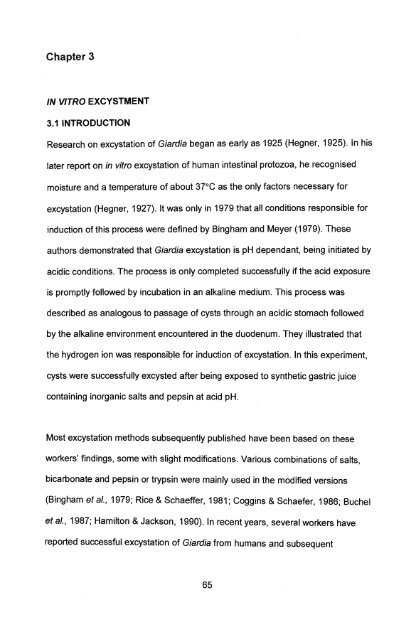in vitro culture and isoenzyme analysis of giardia lamblia
in vitro culture and isoenzyme analysis of giardia lamblia
in vitro culture and isoenzyme analysis of giardia lamblia
You also want an ePaper? Increase the reach of your titles
YUMPU automatically turns print PDFs into web optimized ePapers that Google loves.
Chapter 3<br />
IN VITRO EXCYSTMENT<br />
3.1 INTRODUCTION<br />
Research on excystation <strong>of</strong> Giardia began as early as 1925 (Hegner, 1925). In his<br />
later report on <strong>in</strong> <strong>vitro</strong> excystation <strong>of</strong> human <strong>in</strong>test<strong>in</strong>al protozoa, he recognised<br />
moisture <strong>and</strong> a temperature <strong>of</strong> about 37°C as the only factors necessary for<br />
excystation (Hegner, 1927). It was only <strong>in</strong> 1979 that all conditions responsible for<br />
<strong>in</strong>duction <strong>of</strong> this process were def<strong>in</strong>ed by B<strong>in</strong>gham <strong>and</strong> Meyer (1979). These<br />
authors demonstrated that Giardia excystation is pH dependant, be<strong>in</strong>g <strong>in</strong>itiated by<br />
acidic conditions. The process is only completed successfully if the acid exposure<br />
is promptly followed by <strong>in</strong>cubation <strong>in</strong> an alkal<strong>in</strong>e medium. This process was<br />
described as analogous to passage <strong>of</strong> cysts through an acidic stomach followed<br />
by the alkal<strong>in</strong>e environment encountered <strong>in</strong> the duodenum. They illustrated that<br />
the hydrogeh ion was responsiQle for <strong>in</strong>duction <strong>of</strong> excystation. In this experiment,<br />
cysts were successfully excysted after be<strong>in</strong>g exposed to synthetic gastric juice<br />
conta<strong>in</strong><strong>in</strong>g <strong>in</strong>organic salts <strong>and</strong> peps<strong>in</strong> at acid pH.<br />
Most excystation methods subsequently published have been based on these<br />
workers' f<strong>in</strong>d<strong>in</strong>gs, some with slight modifications. Various comb<strong>in</strong>ations <strong>of</strong> salts,<br />
bicarbonate <strong>and</strong> peps<strong>in</strong> or tryps<strong>in</strong> were ma<strong>in</strong>ly used <strong>in</strong> the modified versions<br />
(B<strong>in</strong>gham et al., 1979; Rice & Schaeffer, 1981; Cogg<strong>in</strong>s & Schaefer, 1986; Buchel<br />
et al., 1987; Hamilton & Jackson, 1990). In recent years, several workers have<br />
reported successful excystation <strong>of</strong> Giardia from humans <strong>and</strong> subsequent<br />
65
















